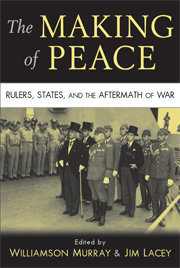Book contents
- Frontmatter
- Contents
- Preface: concluding peace
- 1 Introduction: searching for peace
- 2 The Peace of Nicias
- 3 “A swift and sure peace”: the Congress of Westphalia 1643–1648
- 4 The Peace of Paris, 1763
- 5 In search of military repose: the Congress of Vienna and the making of peace
- 6 War and peace in the post–Civil War South
- 7 Vae victoribus: Bismarck's quest for peace in the Franco-Prussian War, 1870–1871
- 8 Versailles: the peace without a chance
- 9 “Building buffers and filling vacuums”: Great Britain and the Middle East, 1914–1922
- 10 Mission improbable, fear, culture, and interest: peace making, 1943–1949
- 11 The economic making of peace
- 12 Ending the Cold War
- 13 Conclusion: history and the making of peace
- Index
Preface: concluding peace
Published online by Cambridge University Press: 05 June 2012
- Frontmatter
- Contents
- Preface: concluding peace
- 1 Introduction: searching for peace
- 2 The Peace of Nicias
- 3 “A swift and sure peace”: the Congress of Westphalia 1643–1648
- 4 The Peace of Paris, 1763
- 5 In search of military repose: the Congress of Vienna and the making of peace
- 6 War and peace in the post–Civil War South
- 7 Vae victoribus: Bismarck's quest for peace in the Franco-Prussian War, 1870–1871
- 8 Versailles: the peace without a chance
- 9 “Building buffers and filling vacuums”: Great Britain and the Middle East, 1914–1922
- 10 Mission improbable, fear, culture, and interest: peace making, 1943–1949
- 11 The economic making of peace
- 12 Ending the Cold War
- 13 Conclusion: history and the making of peace
- Index
Summary
There are three basic theories of peace. One is that of Thomas Hobbes: Peace is simply the absence of war. The second is that of St. Augustine: Peace is a ‘just order’, rendered ‘just’ by divine decree, or, in more modern times, by popular endorsement. In the former case, sin shatters the natural harmony, in the latter, the devices and interests of the ruling classes. The third theory is that of Immanuel Kant: Peace, though desirable, is not a ‘natural’ condition but has to be ‘established’: created and maintained by constant human effort.
For Thomas Hobbes, writing as he did during the turmoil of Europe's Thirty Years' War, the natural, or default, condition of man was war, a war of all against all, during which life was ‘nastie, poore, solitarie, brutish, and short’. To escape this fate, men had created civil societies to provide protection but were themselves in a state of constant war with each other. Only brief and periodic truces provided peace. Professor Rahe's chapter underlines that this was the view held by the Greek city-states. The signatories of the Peace of Nicias, the first of which we have any enduring record, considered it to be simply ‘a long-term truce, and never imagined that it would be a lasting peace’. Nor did they desire it to be so. For them, war was a necessary bonding activity, as important for social cohesion as for group survival.
- Type
- Chapter
- Information
- The Making of PeaceRulers, States, and the Aftermath of War, pp. vii - xivPublisher: Cambridge University PressPrint publication year: 2008



